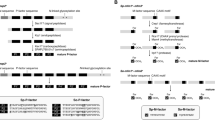Abstract
Thea mating type locus ofUstilago maydis contains the structural genes for a pheromone-based cell recognition system that governs fusion of haploid cells. Binding of pheromone to its cognate receptor induces mating competence in haploid cells and stimulates filamentous growth of the dikaryon. We have analyzed transcription of genes located at thea locus and demonstrate that all genes are induced by pheromone. Transcriptional stimulation is mediated by a 9 bp DNA element (ACAAAGGGA) that occurs in multiple copies in both alleles of thea locus. By fusing multimers containing this 9 bp sequence to the pheromone gene promoter and to a heterologous promoter we demonstrate that this sequence acts as a pheromone response element. In addition, we show that expression of theb genes, which regulate pathogenic development of the dikaryon, is also stimulated by pheromone. Pheromone-inducible genes can be divided into three classes depending on whether their expression is reduced, maintained, or increased after cell fusion. These differences may suggest some regulatory cross-talk between thea andb loci.
Similar content being viewed by others
References
Aono T, Yanai H, Miki F, Davey J, Shimoda C (1994) Mating pheromone-induced expression of themat1-Pm gene ofSchizosaccharomyces pombe: identification of signalling components and characterization of upstream controlling elements. Yeast 10:757–770
Banuett F, Herskowitz I (1989) Differenta alleles ofUstilago maydis are necessary for maintenance of filamentous growth but not for meiosis. Proc Natl Acad Sci USA 86:5878–5882
Banuett F, Herskowitz I (1994) Identification of Fuz7, aUstilago maydis MEK/MAPKK homolog required fora-locus-dependent and -independent steps in the fungal life cycle. Genes Dev 8:1367–1378
Bergemann J (1993) Molekularbiologische Untersuchungen der Transkripte und Produkte desb-Locus vonUstilago maydis. PhD thesis, Freie Universität Berlin
Bölker M, Urban M, Kahmann R (1992a) Thea mating-type locus ofU. maydis specifies cell signalling components. Cell 68:441–450
Bölker M, Urban M, Lauenstein S, Lurz R, Kahmann R (1992b) Genetical and functional organisation of thea mating type locus ofUstilago maydis. In: Nester EW, Verma DPS (eds) Advances in molecular genetics of plant-microbe interactions, vol 2. Kluwer Academic Publishers, Dordrecht, pp 264–271
Bradford MM (1976) A rapid and sensitive method for the quantitation of microgram quantities of protein utilizing the principle of protein-dye binding. Anal Biochem 72:245–248
Dolan JW, Kirkman C, Fields S (1989) The yeast STE12 protein binds to the DNA sequence mediating pheromone induction. Proc Natl Acad Sci USA 86:5703–5707
Froeliger H, Leong SA (1991) Thea mating-type alleles ofUstilago maydis are idiomorphs. Gene 100:113–122
Gillissen B, Bergemann J, Sandmann C, Schroeer B, Bölker M, Kahmann R (1992) A two-component system for self/non-self recognition inUstilago maydis. Cell 68:647–657
Grosschedl R, Giese K, Pagel J (1994) HMG domain proteins: architectural elements in the assembly of nucleoprotein structures. Trends Genet 10:94–100
Holden DW, Kronstad JW, Leong SA (1989) Mutation in a heat-regulatedhsp70 gene ofUstilago maydis. EMBO J 8:1927–1934
Holliday R (1961) The genetics ofUstilago maydis. Genet Res Cambr 2:204–230
Holliday R (1974)Ustilago maydis. In: King RC (ed) Handbook of genetics, vol. 1. Plenum Press, New York, pp 575–595.
Jackson CL, Hartwell LH (1990) Courtship inSaccharomyces cerevisiae: both cell types choose mating partners by responding to the strongest pheromone signal. Cell 63:1039–1051
Jefferson RA (1987) Assaying chimeric genes in plants: the GUS gene fusion system. Plant Mol Biol Rep 5:387–405
Kämper J, Reichmann M, Romeis T, Bölker M, Kahmann R (1995) Multiallelic recognition: nonself-dependent dimerization of thebE andbW homeodomain proteins inUstilago maydis. Cell 81:73–83
Keon JPR, White GA, Hargreaves JA (1991) Isolation, characterization and sequence of a gene conferring resistance to the systemic fungicide carboxin from the maize smut pathogen,Ustilago maydis. Curr Genet 19:475–481
Kronstad JW, Holly JA, MacKay VL (1987) A yeast operator overlaps an upstream activation site. Cell 50:369–377
Laudet V, Stehelin D, Clevers H (1993) Ancestry and diversity of the HMG box superfamily. Nucleic Acids Res 21:2493–2501
Laity C, Giasson L, Campbell R, Kronstad J (1995) Heterozygosity at theb mating-type locus attenuates fusion inUstilago maydis. Curr Genet 27:451–459
Marsh L, Neiman AM, Herskowitz I (1991) Signal transduction during pheromone response in yeast. Annu Rev Cell Biol 7:699–728
Mönke E, Schäfer W (1993) Transient and stable gene expression in the fungal maize pathogenCochliobolus heterostrophus after transformation with theβ-glucuronidase (GUS) gene. Mol Gen Genet 241:73–80
Richard G, Bailey JA, Keon JPR, Hargreaves JA (1992) Development of a GUS reporter gene system for the maize pathogenUstilago maydis. Physiol Molec Plant Pathol 40:383–393
Sambrook J, Fritsch EF, Maniatis T (1989) Molecular cloning: a laboratory manual. Cold Spring Harbor Laboratory Press, Cold Spring Harbor, New York
Schauwecker F, Wanner G, Kahmann R (1995) Filament-specific expression of a cellulase gene in the dimorphic fungusUstilago maydis. Biol Chem Hoppe-Seyler 376:617–625
Schulz B, Banuett F, Dahl M, Schlesinger R, Schäfer W, Martin T, Herskowitz I, Kahmann R (1990) Theb alleles ofU. maydis, whose combinations program pathogenic development, code for polypeptides containing a homeodomain-related motif. Cell 60:295–306
Snetselaar KM (1993) Microscopic observation ofUstilago maydis mating interactions. Exp Mycology 17:345–355
Spellig T, Bölker M, Lottspeich F, Frank RW, Kahmann R (1994) Pheromones trigger filamentous growth inUstilago maydis. EMBO J 13:1620–1627
Sugimoto A, Iino Y, Maeda T, Watanabe Y, Yamamoto M (1991)Schizosaccharomyces pombe stell + encodes a transcription factor with an HMG motif that is a critical regulator of sexual development. Genes Dev 5:1990–1999
Urban M, Kahmann R, Bölker M (1996) The biallelica mating type locus ofUstilago maydis: Remnants of an additional pheromone gene indicate evolution from a multiallelic ancestor. Mol Gen Genet, in press
Author information
Authors and Affiliations
Additional information
Communicated by E. Cerdá-Olmedo
Rights and permissions
About this article
Cite this article
Urban, M., Kahmann, R. & Bölker, M. Identification of the pheromone response element inUstilago maydis . Molec. Gen. Genet. 251, 31–37 (1996). https://doi.org/10.1007/BF02174341
Received:
Accepted:
Issue Date:
DOI: https://doi.org/10.1007/BF02174341



